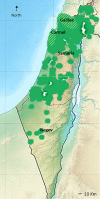The history of olive cultivation in the southern Levant
- PMID: 36909452
- PMCID: PMC9996078
- DOI: 10.3389/fpls.2023.1131557
The history of olive cultivation in the southern Levant
Abstract
The olive tree (Olea europaea L. subsp. europaea var. europaea) is one of the most important crops across the Mediterranean, particularly the southern Levant. Its regional economic importance dates at least to the Early Bronze Age (~3600 BCE) and its cultivation contributed significantly to the culture and heritage of ancient civilizations in the region. In the southern Levant, pollen, pits and wood remains of wild olives (O. europaea subsp. europaea var. sylvestris) has been found in Middle Pleistocene sediments dating to approximately 780 kya, and are present in numerous palynological sequences throughout the Pleistocene and into the Holocene. Archeological evidence indicates the olive oil production from at least the Pottery Neolithic to Chalcolithic transition (~7600-7000 BP), and clear evidence for cultivation by, 7000 BP. It is hypothesized that olive cultivation began through the selection of local genotypes of the wild var. sylvestris. Local populations of naturally growing trees today have thus been considered wild relatives of the olive. However, millennia of cultivation raises questions about whether genuine populations of var. sylvestris remain in the region. Ancient olive landraces might thus represent an ancient genetic stock closer to the ancestor gene pool. This review summarizes the evidence supporting the theory that olives were first cultivated in the southern Levant and reviews our genetic work characterizing local ancient cultivars. The significance and importance of old cultivars and wild populations are discussed, given the immediate need to adapt agricultural practices and crops to environmental degradation and global climate change.
Keywords: archaeobotany; crop wild relatives; landraces; olives; palynology.
Copyright © 2023 Barazani, Dag and Dunseth.
Conflict of interest statement
The authors declare that the research was conducted in the absence of any commercial or financial relationships that could be construed as a potential conflict of interest.
Figures




Similar articles
-
Genetic and phenotypic evidence suggest the existence of indigenous olive population of wild var. sylvestris in the Carmel coast, southern Levant.BMC Plant Biol. 2024 Sep 30;24(1):896. doi: 10.1186/s12870-024-05575-7. BMC Plant Biol. 2024. PMID: 39343909 Free PMC article.
-
Genomic evidence for recurrent genetic admixture during the domestication of Mediterranean olive trees (Olea europaea L.).BMC Biol. 2020 Oct 26;18(1):148. doi: 10.1186/s12915-020-00881-6. BMC Biol. 2020. PMID: 33100219 Free PMC article.
-
Genetic Identification of the Wild Form of Olive (Olea Europaea var. Sylvestris) Using Allele-Specific Real-Time PCR.Foods. 2020 Apr 9;9(4):467. doi: 10.3390/foods9040467. Foods. 2020. PMID: 32283713 Free PMC article.
-
Current Status of Biodiversity Assessment and Conservation of Wild Olive (Olea europaea L. subsp. europaea var. sylvestris).Plants (Basel). 2022 Feb 10;11(4):480. doi: 10.3390/plants11040480. Plants (Basel). 2022. PMID: 35214813 Free PMC article. Review.
-
Molecular studies in olive (Olea europaea L.): overview on DNA markers applications and recent advances in genome analysis.Plant Cell Rep. 2011 Apr;30(4):449-62. doi: 10.1007/s00299-010-0991-9. Epub 2011 Jan 7. Plant Cell Rep. 2011. PMID: 21212959 Review.
Cited by
-
Relationships Between Chemical Compounds and Sensory Properties of Virgin Olive Oil in the US and Israel: Development of a Prediction Model for Defects.J Agric Food Chem. 2024 Nov 13;72(45):25391-25402. doi: 10.1021/acs.jafc.4c06012. Epub 2024 Nov 5. J Agric Food Chem. 2024. PMID: 39499039 Free PMC article.
-
Genetic Diversity of Common Olive (Olea europaea L.) Cultivars from Nikita Botanical Gardens Collection Revealed Using RAD-Seq Method.Genes (Basel). 2023 Jun 23;14(7):1323. doi: 10.3390/genes14071323. Genes (Basel). 2023. PMID: 37510228 Free PMC article.
-
Underrated aspects of a true Mediterranean diet: understanding traditional features for worldwide application of a "Planeterranean" diet.J Transl Med. 2024 Mar 21;22(1):294. doi: 10.1186/s12967-024-05095-w. J Transl Med. 2024. PMID: 38515140 Free PMC article. Review.
-
Role of Olive Bioactive Compounds in Respiratory Diseases.Antioxidants (Basel). 2023 May 23;12(6):1140. doi: 10.3390/antiox12061140. Antioxidants (Basel). 2023. PMID: 37371870 Free PMC article. Review.
-
Revealing the Diversity and Complex Relationships of Croatian Olive Germplasm.Int J Mol Sci. 2024 Mar 9;25(6):3170. doi: 10.3390/ijms25063170. Int J Mol Sci. 2024. PMID: 38542147 Free PMC article.
References
-
- Abbo S., Gopher A., Lev-Yadun S. (2015). Fruit domestication in the Near East. Plant Breed. Rev. 39, 325–377. doi: 10.1002/9781119107743.ch07 - DOI
-
- Abbo S., Lev-Yadun S., Gopher A. (2012). Plant domestication and crop evolution in the Near East: On events and processes. Crit. Rev. Plant Sci. 31, 241–257. doi: 10.1080/07352689.2011.645428 - DOI
-
- Barazani O., Dag A., Kerem Z., Lavee S., Kadereit J. W. (2008). Local old olive landrace varieties in Israel- valuable plant genetic resources in olive cultivation. Israel J. Plant Sci. 56, 265–271. doi: 10.1560/IJPS.56.3.265 - DOI
Publication types
LinkOut - more resources
Full Text Sources

